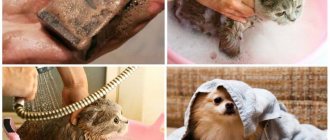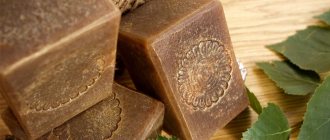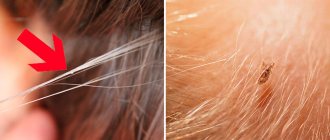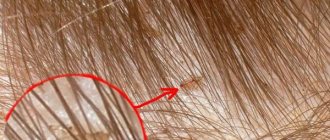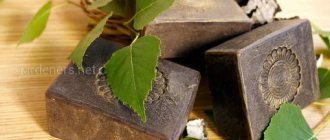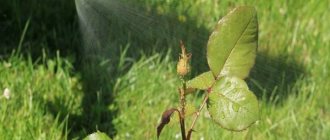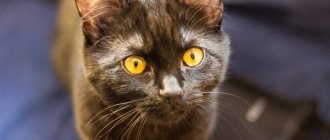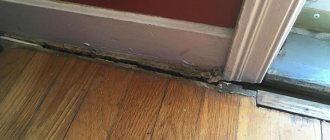04/24/2018Category: PetsAuthor: navseruki
Various medications are now sold to rid pets of fleas and other parasites. However, some owners still prefer to use folk remedies. One of the most popular is tar soap.
- 2 Effectiveness of flea control
- 3 Applications of tar soap
3.1 Video: removing fleas from small kittens with tar soap
Composition and properties
Tar soap is used not only to combat fleas in cats and dogs, but also in the treatment of various dermatological diseases. And although there are now a large number of antiparasitic drugs on the market, the folk remedy is in demand. It includes the following components:
- Birch tar is a natural component that has antiseptic and wound-healing properties. It contains benzoyl, which has a detrimental effect on the receptors of parasitic insects.
- Sodium salts help maintain the water-salt balance of the epidermis and prevent its excessive peeling.
- Alkali and phenol cause burns to parasites and can destroy fungi and pathogens.
- Citric acid can repel fleas.
Auxiliary components include water, thickeners, stabilizers and other substances. Birch tar, which is part of the composition, gives a specific smell and dark brown color.
The product does not contain insecticides and cannot kill insects, although it has a negative effect on them. It is effective against adults, but does not help get rid of eggs and larvae, since the specific smell simply scares the parasites away from the animal. For application to give positive results, soap alone is not enough.
Is it suitable for cats?
In addition to special shampoos intended for hair and skin care, there are drugs whose action is aimed at destroying parasites or fungus. Many cat owners refuse pharmaceutical products, preferring tar soap, because... this product has a number of useful properties.
When used correctly, this soap accelerates the process of cell regeneration and relieves irritation of the epidermis. It has anti-inflammatory and antibacterial effects. The smell of a hygiene product can repel parasites, which serves as a prevention of flea infestation.
But tar soap cannot be used regularly for the procedure either. The choice in favor of this product should be made if there is no special means for washing the animal at home.
Which soap is better - liquid or solid?
Now on store shelves you can find liquid tar soap in pieces. Each release form has its own advantages and disadvantages, so it is difficult to say which is better. Hard pieces are more common. They contain only natural ingredients, but the disadvantage is that they are inconvenient to use. They don't lather well, so they need to be soaked and prepared in advance.
Soap liquid containing tar has the same properties and effects. It is convenient to use (just press the pump once or several times), but often contains surfactants (surface active substances). They dry out the skin excessively, which is especially noticeable with frequent use.
You can now see the current price of soap and buy it right here from Yandex Market with fast delivery:
Traditional methods of treatment
Folk remedies should be used only after prior consultation with a veterinarian. It must be remembered that such treatment methods may not always be effective, especially in the presence of a significant number of parasites. In order to achieve a positive result, it is recommended to use several methods at once.
Cats may be allergic to some folk remedies. It is important to monitor skin reactions during the procedure. If alarming symptoms occur (redness, itching, rashes, vomiting and diarrhea), you should abandon the chosen method and consult a doctor.
Mechanical method
This method is effective only when used in conjunction with anti-blade treatment. If you do not additionally use any anti-parasite remedies, this procedure will not bring any results. Therefore, before you start combing, it is recommended to treat your pet’s fur with any anti-blade shampoo or tar soap. The procedure should be repeated several times a day.
Algorithm of actions:
- Wear gloves. This is a prerequisite, otherwise you can get some kind of infection from fleas.
- Take a fine-tooth comb and comb the cat's fur against the direction of hair growth.
- Gently comb out the parasites, using your fingers to select the larvae, which most often attach closer to the skin. All fleas should be thrown into a jar of boiling water.
- After combing against the grain, you need to do the same only in the opposite direction (according to growth).
A total of up to 5 procedures may be required. It all depends on the method of removing parasites. Even if fleas are completely eliminated, it is necessary to comb out again after 7 days.
Combing fleas from a cat should be done with a special comb.
The mechanical method is not suitable for everyone. Your pet may not like this method because it takes quite a lot of time. This is especially true for active animals accustomed to constant play.
Tar soap
Tar soap is not only a safe, but also a useful way to get rid of fleas and has an antiseptic and wound-healing effect. To eliminate parasites, it is most convenient to use a liquid product. Of course, the animal may not like soap, since it has a pungent odor, but this method in most cases does not cause adverse reactions.
Tar soap has an antiseptic and anti-inflammatory effect
How to use the product:
- Fill the bathroom with hot water. It should be remembered that a comfortable temperature for a cat is 39–40 degrees.
- Rinse the animal's fur and apply tar soap, evenly distributing it over the entire surface of the body.
- Wait a few minutes and rinse off the foam thoroughly.
- Wrap your pet in a towel. When the fur is dry, comb out the fleas.
Attention! Under no circumstances should soap get into your pet's eyes or mouth. The muzzle area must be treated very carefully.
A friend has a cat who at one time was periodically itching. At first she didn’t attach much importance to it, but then she noticed that the pet had fleas. I decided not to use chemicals and bought tar soap. Its smell, of course, is not for everyone, but it is a very effective remedy. After washing the cat 3 times using this soap, a friend noticed that all the parasites had disappeared. In addition, the cat’s fur became fluffy and soft. This soap can eliminate pathogenic microflora and is especially effective against fungi.
Medicinal herbs
To eliminate this problem, you can use the following herbs:
- Sagebrush. Medicinal raw materials do not have a toxic effect on the body and do not cause allergic reactions. To process one animal, you will need 20 g of raw material, which needs to be filled with 500 ml of water and put on fire. Cook for 10 minutes, then let sit for another hour. Then filter and add 1 drop of lavender essential oil. After this, rinse the pet’s fur with the resulting liquid and wrap it in a towel. Allow the animal to dry and comb it. The procedure must be repeated 2-3 days in a row.
- Tansy. Dry raw materials in the amount of 20 g should be poured with 600 ml of boiling water and allowed to brew for about 2 hours. Then filter, heat slightly (up to 40 degrees) and rinse your pet’s fur. Repeat the procedure 2-3 days in a row. When using this method, it is important to comb out the parasites.
- Celandine. This remedy can provoke an allergic reaction, so using it too often is not recommended. First of all, you need to prepare an infusion. For this, 1 tsp. dry herbs should be poured with 300 ml of boiling water and left for an hour. Then strain the liquid and, moistening a cotton pad in it, treat the pet’s fur. You need to do this for several days in a row. It is important to ensure that the cat does not lick the infusion from the surface of the fur, so it is recommended to use a special collar. After the pet has dried, it is necessary to comb it out.
- Geranium and lavender. The herbs need to be mixed in equal proportions and take 60 g of raw material, which should be poured into 1 liter of water and cooked for a quarter of an hour. Then cool to 40 degrees and filter. Use to rinse the animal for 2-3 days in a row. After the wool has dried, comb it out, as in other cases.
If, when using raw materials, the pet’s itching increases, the cat becomes lethargic and the appetite worsens, then this is considered a manifestation of intolerance to the plant component. In this case, it is recommended to abandon the use of herbs and use another method.
Pine sawdust
Pine sawdust has a specific odor that fleas cannot tolerate, so this product is used as an auxiliary treatment method. The raw materials are placed under the pet’s bedding or sewn into it, and also placed in the corners of the living room so that the parasites leave the area faster. It should be understood that pine sawdust is not able to rid an animal of a large number of fleas, so this method is recommended to be combined with those presented above.
Pine sawdust can repel fleas
This method is environmentally friendly and safe for both the cat and the residents of the house. Pine sawdust has a pleasant and light pine aroma, which does not cause discomfort to pets and people, but repels various insects.
Hellebore water
This product is one of the most effective, but at the same time not entirely safe for your pet. If hellebore water gets into the gastrointestinal tract, severe poisoning with subsequent death is possible, so the liquid must be used with extreme caution.
Hellebore water is effective against lice, fleas and lice-eaters
Sequencing:
- Wear gloves and place the animal in the bathtub or on the floor.
- Dip a cotton pad in hellebore water and treat the entire coat with the liquid, except the muzzle and anus.
- Wrap your pet in a towel and wait 15 minutes.
- Then rinse thoroughly with shampoo.
- Repeat the procedure in a week.
Attention! Under no circumstances should hellebore water be applied without wearing gloves, as this product is toxic.
Vinegar to the rescue
Vinegar has been used for decades to combat lice and fleas. To enhance the effect, it is also recommended to use ammonia. Cats really don't like this smell, but the results are worth a try. You need to add 2 tsp to 200 ml of vinegar. ammonia.
Regular table vinegar is suitable for this procedure.
Spray the resulting mixture over the surface of the wool using a spray bottle. Then wrap the animal in an old towel or plastic, leaving the muzzle outside. After 10 minutes, rinse thoroughly with shampoo. Then dry the wool with a hairdryer. As a rule, one procedure is enough.
Ammonia is harmful to parasites
To treat cat hair, you should not use vinegar essence, which is very concentrated and can cause irritation. A regular table version of 6 or 9% is suitable.
How to use?
If you decide to use tar soap for cats, follow these steps:
- Pre-lather the soap (you can soak a piece in water). If you use it in liquid form, these manipulations will not be necessary.
- Wet the animal's fur thoroughly.
- Lather the cat, avoiding getting the foam into the ears, mouth, and eyes to avoid irritation of sensitive areas.
- Without rinsing off the foam, wrap it in an old towel and hold it for 5-7 minutes.
- After this, rinse the wool thoroughly with water and dry it.
- Gently comb the animal, removing parasites and their eggs.
If the infection is severe, then after the first soaping you need to wash off the foam along with most of the parasites, and then soap again and leave for 5-7 minutes. The procedure must be repeated every 2-3 days until the insects disappear completely. It is advisable to carry out the procedure together, since cats usually do not like bathing, so they try to run away.
It is equally important to treat the premises and prevent re-infection. To do this, the bedding is changed or washed, the dishes, house and other items of the animal are treated with steam. Special insecticidal agents are used in the house, paying special attention to places near baseboards, under the bathroom, and behind cabinets.
To eliminate the possibility of re-infection, it is advisable to use a collar before walking outside, unless there are contraindications.
Is it effective against lichen?
Tar reduces the activity of bacterial and fungal microflora, so soap containing this element can be used to treat lichen in cats. To cure an animal, apply foam to the affected area and leave for 15 minutes.
You can also make pasta. You will need to rub the bar, fill it with warm water, and then wait until the crushed particles are completely dissolved. You should get a homogeneous mass. It is applied daily to the lichen, and after 15-20 minutes it is washed off with water.
Contraindications
Tar soap has no contraindications. It can be used for kittens from 5 weeks, for pregnant and lactating cats. Swimming is also not prohibited if there are wounds, cuts or other injuries on the skin. Birch tar has an antiseptic effect and triggers regeneration processes, accelerating wound healing.
Soap does not have a toxic effect on the body, so it is well suited for controlling fleas in weakened and old animals, as well as those that have undergone surgery or serious illness.
The only contraindication is individual intolerance to the components. If irritation, redness or itching occurs, you should stop using the product further and look for an alternative.
Precautionary measures
Just like humans, cats may exhibit individual sensitivity to certain drugs.
Rarely, but it can also be associated with tar soap. If your pet exhibits unusual behavior while using the product, you should immediately wash off the composition. If symptoms persist, contact your veterinarian. Frequent sneezing, coughing, excessive drooling, or fainting of the cat should alert you. You can test your cat for sensitivity by applying a little soap to a place where she will not lick it off. For example, on the skin of the withers. If after a day there are no negative symptoms, the product can be used to combat fleas. Another danger is soap suds getting on the animal’s mucous membranes. This can cause irritation, and if the cat eats the soap, it can cause stomach upset.
To avoid getting it in the eyes, you need to soap it very carefully, and also carefully monitor that the cat does not swallow the product.
Advantages and disadvantages
The advantages include:
- availability and low price (about 50-60 rubles);
- high efficiency;
- natural composition;
- absence of harmful substances;
- Possibility of use for small kittens.
The disadvantages are the following:
- strong unpleasant odor;
- the need for re-processing;
- complexity of the procedure (animals usually do not want to bathe).
In addition, the product does not act against flea eggs, so additional measures must be taken.
What else is worth knowing?
There are some nuances and secrets of using tar soap:
- Regularity of processing, as mentioned above. A single procedure will not bring any results.
- If there are other pets in the house and no fleas were noticed on them, then they still need to be “treated” with tar soap. Sooner or later, insects may appear on uninfected animals. But the tar will scare them away.
- Tar soap against fleas should be used not only when bathing a cat. It is recommended to treat the entire apartment with this product: carpets, floors, areas under sofas and baseboards, and other hard-to-reach areas.
- Pets need to change their bedding periodically. It would also be a good idea to thoroughly clean the areas where cats spend a lot of time using tar soap.
Owner reviews
Alexandra, the kitten's owner:
“My daughter brought a cute kitten from the street. I was constantly itching and found fleas. They were afraid to use special drops because the kitten was very small (about a month old). They bathed with tar soap. When lathering, fleas jumped straight out of the fur. After repeated treatment 4 days later, Murzik stopped itching. An affordable and effective remedy, however, it is very smelly.”
Anna, owner of a 2-year-old cat:
“Our cat began to itch constantly. In some places it even scratched the skin. We went to the clinic, the doctor recommended German antiparasitic drops, but they did not help us. The cat continued to itch. On the advice of a friend, I bought soap with tar. After the first bath, the pet stopped itching, and the wounds began to heal.”
Applications of tar soap
Some difficulties in using tar soap against fleas can be caused by cats' eternal dislike of water. It is recommended to carry out the treatment together with someone, so that one person holds the cat, and the other does soaping and rinsing with water. This advice is especially relevant for large pets that are difficult to keep in place.
- The cat is placed in a container of water.
The water container should not be too deep so that the cat has the opportunity to hold on to its edge with its paws. - Carefully lather it with massaging movements so that the wool is saturated with tar foam.
You need to lather thoroughly, but carefully so that the foam does not get into the eyes, nose and mouth of the animal. - Wrap in thick fabric, such as an old towel.
The cat needs to be wrapped in a towel or other thick fabric so that the effect of tar on fleas is maximum. - After 10 minutes, wash off the foam, rinsing the wool well with water.
The wool needs to be rinsed well, but do not do this with too strong a stream of water. - Dry your pet with a dry towel.
You need to dry the cat well with a towel so that the fur dries immediately and he doesn’t catch a cold. - After the coat has dried, you need to comb it well, combing out the remains of parasites.
To comb out fleas, it is better to use a special metal comb with fine teeth and rounded blunt edges. - To achieve the best result, two to three treatments are carried out at intervals of four to five days.
After treatment, it is imperative to comb out parasites from the fur. This way, surviving and dead fleas, as well as larvae, will be destroyed, and the cat will not subsequently lick off the dead fleas. It is better to carry out combing in the bathtub, on newspaper or other bedding, which can then be thrown away along with the insects.
The author of the article had to bathe the cat several times. The result was her fright and scratches on the owner. Such a violent reaction is especially characteristic of some emotional cat breeds, for example, Siamese. But to one degree or another, almost all cats do not like water. As I noticed with my pet, it is better if the bathing container is shallow - my cat held the edge of the pelvis with her paws, probably feeling more secure in this position. It is advisable to pour water not to the brim, so that not the entire body is in it and the pet is less afraid. It is better to protect the hands of the person who bathes the animal with fabric household gloves - it may not be as comfortable, but the risk of scratches and bites will be reduced.
To reduce the cat's stress from bathing, some owners rub the foam into the dry fur without placing the cat in the basin. This way, the animal gets into the water only when it is necessary to wash off the product. If this method is chosen, it is worth taking care of the bedding during application. The disadvantage of this method is that it is difficult to rub foam into the dry fur of long-haired cats so that it reaches the skin.
Video: removing fleas from small kittens with tar soap
Effectiveness of flea treatment
The main advantage of tar soap is safety for the cat. Unlike special means for combating fleas, it can be used on pregnant animals and kittens at any age (insecticides - only from two months). Also, the tar in the composition has a healing effect on inflammation resulting from flea bites. Other advantages:
- cheapness;
- beneficial effect on the skin and fur of the cat;
- soap can be used if the animal has wounds and scratches, unlike many aggressive chemicals.
Tar soap also has disadvantages:
- does not always get rid of fleas completely;
- repeated treatments are required;
- unpleasant odor for some;
- difficulty of use due to the need to wash the cat
Tar soap "Clandestine" is sold in pet stores
There is a special tar soap for animals, “Clandestine,” which relieves pets of fleas.
Bathing a cat with soapy water
The process of bathing a cat is difficult, since these animals are terribly afraid of water (with rare exceptions). Bathing your pet with tar soap will cause him even more inconvenience because the smell is too strong. In this situation, you cannot do without an assistant.
Bathing rules:
- Prepare a bath or basin with water, a towel and soap in advance.
- Check the water temperature – it should correspond to the cat’s body temperature.
- Put mittens on your hands and your assistant's.
- Wet the animal's fur and thoroughly soap it.
- It is easy to massage your pet so that he is not afraid.
- After 10 minutes, start rinsing off.
- If you see that the fleas are moving, you should repeat the manipulations.
- Wrap the cat in a towel.
The best drugs and folk remedies for getting rid of fleas from a cat
On a note! Prepare a soap solution or thick foam and apply to the animal. It doesn't hurt the animal that much. You can quickly bathe your pet in a soapy solution.
